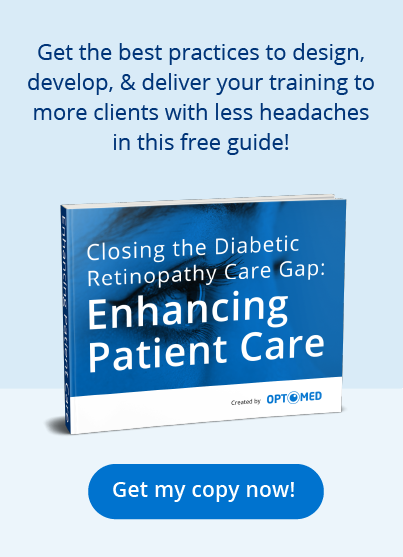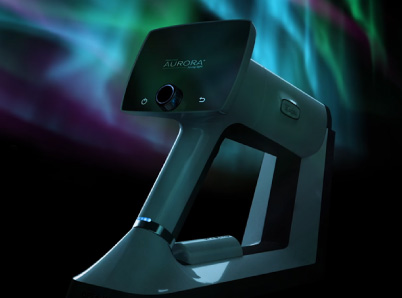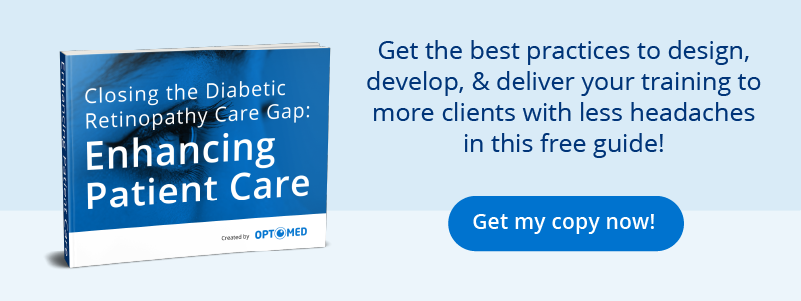Diabetes is increasing rapidly in the United States, and so is the secondary complication of diabetic retinopathy (DR). One-third of those with diabetes will end up with DR, and one-third of those people will have sight-threatening levels of diabetic retinopathy.
DR is the leading cause of blindness in the economically active, working-age population. It accounts for around 15-17% of total blindness in the United States and Europe.
Yet, it is a treatable and preventable disease. DR has a significant negative impact on patients and healthcare professionals. Diabetes is expected to continue growing in number, so it’s time to improve diabetic eye screenings to help patients and healthcare professionals alike.
Health care professionals should be doing everything possible to prevent this blinding eye condition. What can speed up facilitating the care of diabetic retinopathy is improved eye screenings using retinal photography.
The Gap in Care with Eye Screenings for Diabetic Retinopathy
According to the American Academy of Ophthalmology, 60% of Americans with diabetes are not receiving the critical eye care screenings that they need to detect diabetic retinopathy. There are numerous reasons for care gaps in diabetic eye screenings.
A large gap in care starts when patients don’t have access to fundus imaging. Retinal photography is often completed in ophthalmologists’ offices when doing routine exams. But what about diabetic patients who don’t see an ophthalmologist regularly? They’re missing critical eye screenings and the possible early detection of diabetic retinopathy.
The traditional desktop fundus camera that provides retinal images for diabetic eye screenings is often only used in ophthalmology offices. They’re stationary devices, which limits availability to diabetic patients, especially in rural areas. Rural populations have been found to have limited access to healthcare and have to travel long distances for eye care screenings.
There are now technological advancements and devices that can help close the gap in diabetic eye screenings. One of those ways is with Optomed Aurora, a handheld fundus camera.
Handheld Retinal Photography Is the Solution to Close Care Gaps in DR Eye Screenings
Handheld fundus imaging with Aurora is the future of diabetic eye care screenings. Optomed Aurora provides versatility compared to desktop fundus cameras. Mobility with a handheld device enables increased eye screenings and with ease, since the camera is lightweight and easy to use.
Aurora provides a 50-degree view of the retina compared to the 5-degree view of a direct ophthalmoscope, allowing for faster screening. It is particularly useful in screening for diabetic retinopathy. Aurora also functions without the need for dilation.
Handheld fundus cameras can reach more people when utilized by more healthcare professionals, such as primary care physicians.
Optomed Aurora Will Revolutionize DR Eye Screenings
Diabetic patients need to have easier ways to access their eye screenings. Optomed Aurora is mobile and easy to transport, allowing healthcare professionals, like primary care doctors, to use it in multiple clinics and locations. The camera is easy to use for both the patient and the doctor.
Having quality retinal images will increase DR eye screenings worldwide. Not requiring dilation also saves time and is easier for the patient, leading to improved satisfaction.
Artificial intelligence (AI) is another valuable tool in the eye screenings of diabetic patients. Aurora can integrate with AI to support health care professionals in diagnosing and treatment planning when ophthalmologists can view images remotely.
Using AI, primary care physicians can play a large role in referring patients to ophthalmologists when needed. Since many diabetic patients aren’t routinely seeing ophthalmologists, primary care physicians can help close the gap by using Aurora in their clinics.
With Aurora in the hands of primary care physicians, this type of telemedicine can be utilized to screen more diabetic patients. This will allow for early intervention before significant vision impairment occurs, because ophthalmologists will have quality retinal images to interpret. Early detection of diabetic retinopathy is essential for the prevention of blindness in patients with diabetes. Adding retinal photography into primary care clinics will close the care gap in diabetic eye screenings.
Primary Care Physicians Using Aurora Will Help Close the Gap on Diabetic Eye Screenings
The vision-threatening damages of diabetic retinopathy can be prevented when more patients have access to retinal photography using Optomed Aurora. The increase of eye care screenings will allow more people to have a chance to prevent significant vision loss or blindness. When primary care doctors incorporate retinal imaging into their clinics, people with diabetes can be screened and intervention can be accomplished faster.
The late stages of diabetic retinopathy cause the most vision impairment in patients. Early detection is crucial, so when primary care doctors use Aurora in their offices, proper referrals to ophthalmologists can be obtained sooner. Ophthalmologists will then have the chance to stop diabetic retinopathy from progressing, saving the sight of millions of patients. Primary care doctors using Optomed Aurora is one of the most significant ways to close the care gap in diabetic screenings.
Here at Optomed, our mission is to help save the vision of millions of people. By integrating our software and artificial intelligence solutions with our camera, we enable eye screening for everyone, wherever they are. To see how we can equip you to save the sight of more patients, schedule a free consultation today!



